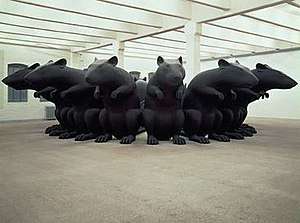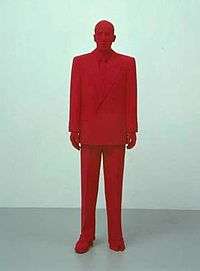Katharina Fritsch
Katharina Fritsch (born 14 February 1956) is a German sculptor.[1] She lives and works in Düsseldorf, Germany.[1]



Early life and education
Katharina Fritsch was born on February 14, 1956 in Essen, West Germany.[1][2] Fritsch first studied history and art history at the University of Münster and, in 1977, transferred to Kunstakademie Düsseldorf where she was a student of Fritz Schwegler until 1984.
Work
Katharina Fritsch is known for her sculptures and installations that reinvigorate familiar objects with a jarring and uncanny sensibility. Her works' iconography is drawn from many different sources, including Christianity, art history and folklore. She attracted international attention for the first time in the mid-1980s with life-size works such as a true-to-scale elephant. Fritsch's art is often concerned with the psychology and expectations of visitors to a museum.
Gary Garrels wrote that “One of the remarkable features of Fritsch’s work is its ability both to capture the popular imagination by its immediate appeal and to be a focal point for the specialized discussions of the contemporary art world. This all too infrequent meeting point is at the center of her work, as it addresses the ambiguous and difficult relationships between artists and the public and between art and its display—that is, the role of art and exhibitions and of the museum in the late twentieth century.” [3] The special role colour plays in Fritsch's work has roots in her childhood visits to her grandfather, a salesman for Faber-Castell art supplies, whose garage was well-stocked with his wares.[4]
Her most recognized works are Rattenkönig/Rat King (1993), a giant circle of black polyester rats, included in the Venice Biennale in 1999. Other works include Mönch (Monk) (2003), a stoic, monochromatic male figure, made of solid polyester with a smooth, matte black surface; Figurengruppe / Group of Figures (2006-2008), an installation of nine elements; and Hahn/Cock (2010), a 14 ft (4.3m) cockerel in ultramarine blue to be shown on London's Trafalgar Square Fourth plinth from July 2013 to January 2015.[5]
In her working process, Fritsch combines the techniques of traditional sculpture with those of industrial production. While many of her early works were handcrafted, Fritsch now makes only the models for her sculptures and then hands these over to a factory for production, to "near-pathological specifications".[6] She uses these models to create moulds, from which the final sculptures are cast in materials such as plaster, polyester and aluminium. Many are made as editions, meaning that multiple casts are taken from one mould.[7] For the duration of some of her exhibitions, Fritsch has made her multiples available for sale at the respective museums.
When working with human forms, Fritsch often collaborates with a model named Frank Fenstermacher. One of her muses,[8] he “stands for the generic ‘man’” in works such as her three ‘bad’ men: The Monch, the Doktor and the Handler.[8] Fritsch explains her prolonged working relationship with Frank in terms of expression: "Somehow Frank's able to express what I want to express. I don't know why. Maybe he looks a little bit like my father, or like me. And he's a kind of actor. It's very strange how he can change from one character to another without appearing to do anything. He's always the man."[9] Fritsch's process in creating human figures is similar to her animal or object creations, except a live human is involved. She takes photographs of the model, trying out ideas and recording the details of the model's position. In the creation of the mold, she and her plaster technicians cover the model in vaseline and create the mold on top. After a dramatic, near death situation in which Frank was covered in too much plaster and turned blue, with his head “lolling forwards”[8] Fritsch has made fully body casts from mannequins. She still uses human models for the face and hands of her figures. After Fritsch is happy with the plaster mold, she uses silicon to make a negative model and then polyester to create a positive form from the silicon.[8] The different pieces are painstakingly put together because “the surface has to be absolutely perfect.”[8] Fritsch then paints or sprays the sculpture to finish it.
In her work, Fritsch has been credited in continuing the work of Marcel Duchamp by responding to his ideas and change viewers’ perceptions of them. For example, Fritsch's first major piece in the Museum of Modern Art's collection was Black Table with Table Ware (1985).[10] It, outside of a museum, could be seen as an everyday object but it is “strangely symmetrical”[10] and placed in a museum context, changing the viewer's approach to it, much like Duchamp.
In 2001, Fritsch was appointed Professor of Sculpture at the Academy of Fine Arts, Münster, a post she held until 2010. She is currently Professor of Sculpture at Kunstakademie Düsseldorf.
Exhibitions
Fritsch showed her first sculptures in 1979. Her international breakthrough came in 1984 at Düsseldorf's ‘Von hier aus’ (From Here On) exhibition. In 1988 she exhibited at the Kunsthalle Basel and in 1997 at the Museum für Gegenwartskunst.[11] Her first major exhibition in the U.S. was held at Dia Center for the Arts in 1993.[12] In 1995 Fritsch represented Germany along with artists Thomas Ruff and Martin Honert in the German Pavilion, which was curated by Jean-Christophe Ammann, at the Venice Biennale.[13] Her work has since been the subject of exhibitions at the San Francisco Museum of Modern Art, the Tate Modern, and the Museum of Contemporary Art, Chicago as well as of a survey exhibition at Kunsthaus Zurich and Deichtorhallen (2009). In 2012, an exhibition of her work was installed on the Bluhm Family Terrace at the Art Institute of Chicago.
Other solo exhibitions have included:
1984- Katharina Fritsch Rudiger Schottle, Munich
1985- Katharina Fritsch Galerie Johnen & Schottle, Cologne
1987- Katharina Fritsch: Elefant Kaiser Wilhelm Museum, Krefeld, West Germany
1988- Katharina Fritsch Kunsthalle Basel and Institute of Contemporary Arts, London
1989- Katharina Fritsch Westfalischer Kunstverein, Munster[14]
2017 - Multiples, Walker Art Center, Minneapolis, United States[15]
Her work has also been shown internationally alongside other artists at the Carnegie Museum of Art (1991), Martin-Gropius-Bau in Berlin, Germany (1991), Verlag Gerd Hatje in Stuttgart, Germany (1997), The Jewish Museum in San Francisco (2004), Deste Foundation for Contemporary Art in Greece (2004), The Museum of Modern Art in New York (2008), and the Gwangju Biennale in South Korea (2010).[16]
Public collections
Fritsch's work is currently represented in the permanent collections of the Museum of Modern Art, New York; the Philadelphia Museum of Art; the Walker Art Center, Minneapolis; the Staatsgalerie Stuttgart; and the Museum Brandhorst, Munich.
Art market
She has been represented by Matthew Marks Gallery in New York since 1994, and has exhibited with White Cube in London.[17]
Awards
- 1984 Kunstpreis Rheinische Post, Düsseldorf
- 1989 Kunstpreis Glockengasse, Cologne
- 1994 Coutts & Co. International Award, London
- 1996 Kunstpreis Aachen
- 1999 Junge Stadt sieht Junge Kunst, Wolfsburg
- 2002 Konrad-von-Soest-Preis des Landschaftsverband Westfalen-Lippe
- 2008 Piepenbrock Preis für Skulptur
- 2014 Kunstpreis Düsseldorf
See also
References
- "Katharina Fritsch: Artist Biography"' Archived 2015-09-06 at the Wayback Machine, Dia Art Foundation, Retrieved 23 October 2015.
- Phaidon Editors (2019). Great women artists. Phaidon Press. p. 145. ISBN 0714878774.
- Gary Garrels, “Katharina Fritsch: An Introduction,” in Katharina Fritsch (San Francisco: San Francisco Museum of Modern Art, 1996), 12.
- Colour Chart: Reinventing Colour, 1950 to Today Moma.
- Mark Brown (January 14, 2011), Fourth plinth at Trafalgar Square gets (no sniggering) a 14ft blue cock The Guardian.
- White Cube, London.
- http://www.tate.org.uk/whats-on/tate-modern/exhibition/katharina-fritsch
- Katharina Fritsch. London: Tate Publishing. 2002. pp. 93–109. ISBN 0-8109-6268-3.
- Gayford, By Martin. "The rodent that roared". Telegraph.co.uk. Retrieved 2017-03-11.
- Storr, Robert (1997-01-01). "The Here and Now That's Here to Stay". MoMA (26): 19–21. JSTOR 4381368.
- KATHARINA FRITSCH, June 3 - August 30, 2009 Archived March 23, 2012, at the Wayback Machine Kunsthaus Zürich.
- "Archived copy". Archived from the original on 2010-06-13. Retrieved 2011-01-18.CS1 maint: archived copy as title (link)
- "History of the German Pavilion" Archived 2016-03-04 at the Wayback Machine, Deutscher Pavilion, Retrieved 13 October 2015.
- Culture and Commentary An Eighties Perspective. Washington, D.C.: Hirshhorn Museum and Sculpture Garden. 1990. pp. 174. ISBN 0-9623203-2-3.
- "She's the artist behind that giant blue chicken coming to Minneapolis Sculpture Garden". Star Tribune. Retrieved 2017-05-23.
- "Contemporary Artists Index". Cleveland Institute of Art. Retrieved 13 December 2019.
- Katharina Fritsch Matthew Marks Gallery, New York.
Selected bibliography
- Katharina Fritsch. San Francisco: San Francisco Museum of Modern Art, 1996.
- Katharina Fritsch. Wolfsburg: Stadische Galerie Wolfsburg, 1999.
- Katharina Fritsch. New York: Matthew Marks Gallery, 2000.
- Blazwick, Iwona. Katharina Fritsch. London: Tate, 2002.
- Figure in the Garden: Katharina Fritsch at The Museum of Modern Art. Cologne: Walther König, 2013.